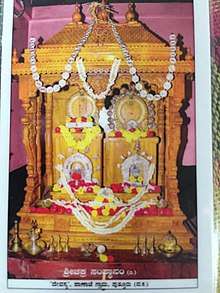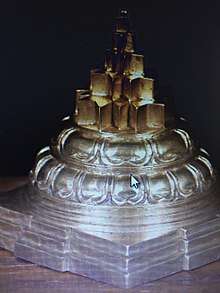Rakteswari
Rakteswari[1][2] (also Rakteshwari), identified as an aspect of Adi Parashakti, also known as Durga Parameswari, is a principal and popular form of Hindu goddess worshipped mainly in Parshurama Kshetras.[3][4][5] Rakteswari is the iṣṭa-devatā (tutelary deity) of Tulu Nadu.[6][7][8]
Worship and festivals
Rakteswari is Durga Parameswari,[9] the divine mother of universe,[10][1] worshipped in Hindu temples of India by Shakta Hindus. Her temples, worship and festivals are particularly popular in Indian subcontinent during every Sankramana (or Sankranthi days/ Sun transit days of every month in Hindu calendar). Coconut flowers, Vermilion and whole coconuts are the significant offerings for her worship.
The beeja-mantra of Rakteswari, Om Kleem Ram Rakteswaryai namaha, is recited on Sikharagra (on top of a mountain), near a flowing river, any dense forest, Kadamba trees garden,etc. under the guidance of a competent guru as any shakta (Shakta Upanishads) tradition requires.

Deity Rakteswari is often misunderstood as a spirit/demon. Dakshinachara sects are dismissive of Rakteswari as a goddess who demands blood sacrifice.She is a fierce deity worshipped in her calm posture in dakshinachara path (Right-Hand Path) with kumkum (Vermilion) and whole coconut as bali (offerings). Speciality of the goddess worship is that it bestows the seeker with a power to extract negative energies (i.e. any blockages in shat chakras (centers of energy) of human body causing anxiety, fear, depression, loss of appetite, anger, frustrations, loss of concentration, etc.) from other human beings using certain mudras (internalized energetic practices) especially on Sankramana days of every month (refer to table below for exact dates).
| Sankrama Date | Sun Transit sign |
|---|---|
| 14 Jan | Capricorn |
| 13 Feb | Aquarius |
| 14 Mar | Pisces |
| 14 Apr | Aries |
| 15 May | Taurus |
| 15 Jun | Gemini |
| 16 Jul | Cancer |
| 17 Aug | Leo |
| 17 Sep | Virgo |
| 17 Oct | Libra |
| 16 Nov | Scorpio |
| 16 Dec | Sagittarius |
Some accomplished Rakteswari worshippers are known for performing spiritual healing (cleansing of the blockages of seven chakras in human body) through mastery of Rakteswari worship. Prescription of beej mantra "AUM" is done (time of recitation could vary based on the specific blockages) as one of the main satvik post-healing processes.
Planet Mars and its association with goddess Rakteswari
In traditional Hindu astrology, Moon, Mars are the chief significators of blood in human body. When Mars is afflicted in any horoscope and it occupies an even sign, then goddess Rakteswari has to be propitiated to get rid of any blood related disorders.[11] As per some local beliefs, contagious diseases like Smallpox and menstrual bleeding disorders(Mars represents private parts of body too) can be cured by worshipping Rakteswari [12]
The Vamamarga worship( Left-Hand Path or alternate path which uses wine, meat, blood, animal sacrifices, etc.) of Rakteswari is not ruled out in folklore genre.[13] The Folk performances mandate music, folk dance, recital and other elaborate vesha (costumes ) as outlined in Dravidian Tulu Oral folk literature, [14] Cow ghee lamp and Kumkum (Vermilion) are offered to appease Rakteswari in typical household worship, like any other female deity.
Temple

The regions of Konkan, coastal Karnataka and Kerala, considered as Parashurama Kshetra, have numerous temples[4][8][15] dedicated to Rakteswari. Worship of Rakteswari by Brahmins[16][17] and many other various Hindus in mulasthana[16] is famous in South Canara.
Rakteshwari, in Dakshinachara (Right-Hand Path) tradition, is depicted as srichakravasini (peaceful and soothing deity as a resident of the tip of Sri Chakra) and worshipped[9] as Durga Parameswari by Durga sukta and Śrī Sūkta.[18]
Iconography
Sword, one of the divine weapons of Adi Parashakti, which represents elimination of Discrimination according to Devi Mahatyam, is a symbolic form of goddess Rakteswari. The tip of Sri Chakra is an iconic form of the supreme goddess, Durga Parameswari.
References
- Caldwell, Sarah (1999). Oh Terrifying Mother: Sexuality, Violence, and Worship of the Goddess Kā̄ḷi. Oxford University Press. ISBN 978-0-19-565796-8.
- Raman, Bangalore Venkat (September 1999). Prasna Marga. Motilal Banarsidass. ISBN 978-81-208-0918-5.
- Shah, Umakant Premanand (1995). Studies in Jaina Art and Iconography and Allied Subjects in Honour of Dr. U.P. Shah. ISBN 978-81-7017-316-8.
- Jayashanker, S. (2011). Temples of Erṇākuḷam District. Office of the Registrar General & Census Commissioner, India.
- Ayyar, K. V. Krishna (1938). The Zamorins of Calicut: From the Earliest Times Down to A.D. 1806. Publication Division, University of Calicut. ISBN 978-81-7748-000-9.
- JIF, Journal of Indian Folkloristics. Folklore Fellows of India. 1978.
- Siraj, S. Anees (2012). Karnataka State: Udupi District. Government of Karnataka, Karnataka Gazetteer Department.
- "Filled with lore". The Hindu. 2008-06-09. ISSN 0971-751X. Retrieved 2018-04-30.
- Das, Potluru Krishna (1989). The Secrets of Vastu. Udayalakshmi Publications.
- Johnsen, Linda (2002). The Living Goddess: Reclaiming the Tradition of the Mother of the Universe. Yes International Publishers. pp. 89–90. ISBN 978-0-936663-28-9.
- Raman, Bangalore Venkat (September 1999). Prasna Marga by BV Raman. ISBN 9788120809185.
- Ltd, Infokerala Communications Pvt (2017-09-01). Pilgrimage to Temple Heritage 2017. Info Kerala Communications Pvt Ltd. ISBN 978-81-208-0918-5.
- Claus, Peter J. (1978). "Oral Traditions, Royal Cults and Material for the Reconsideration of the Caste System in South India"". Journal of Indian Folkloristics. 1 (1): 1–39.
- Claus, Peter J) (1978). "Heroes and Heroines in the Conceptual Framework of Tulu Culture". Journal of Indian Folkloristics. 1 (2): 28–42.
- Ltd, Infokerala Communications Pvt (2017-09-01). Pilgrimage to Temple Heritage 2017. Info Kerala Communications Pvt Ltd. ISBN 978-81-934567-0-5.
- JIF, Journal of Indian Folkloristics. Folklore Fellows of India. 1978.
- JIF, Journal of Indian Folkloristics. Folklore Fellows of India. 1978.
- Sankaranarayanan, S. (2001). Glory of the Divine Mother (Devī Māhātmyam). India: Nesma Books. ISBN 978-81-87936-00-8.